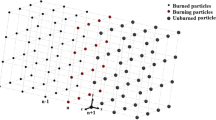Abstract
In this research combustion of aluminum dust particles in a quiescent medium with spatially discrete sources distributed in a random way was studied by a numerical approach. A new thermal model was generated to estimate flame propagation speed in a lean/rich reaction medium. Flame speed for different particle diameters and the effects of various oxidizers such as carbon dioxide and oxygen on flame speed were studied. Nitrogen was considered the inert gas. In addition, the quenching distance and the minimum ignition energy (MIE) were studied as a function of dust concentration. Different burning time models for aluminum were employed and their results were compared with each other. The model was based on conduction heat transfer mechanism using the heat point source method. The combustion of single-particle was first studied and the solution was presented. Then the dust combustion was investigated using the superposition principle to include the effects of surrounding particles. It is found that larger particles have higher values of quenching distance in comparison with smaller particles in an assumed dust concentration. With the increase of dust concentration the value of MIE would be decreased for an assumed particle diameter. Considering random discrete heat sources method, the obtained results of random distribution of fuel particles in space provide closer and realistic predictions of the combustion physics of aluminum dust flame as compared with the experimental findings.
Similar content being viewed by others
References
ECKHOFF R K. Dust explosion in the process industries [M]. Oxford: Butterworth, 1997.
MOSTAFAVI S A, SALAVATI S, DIZAJI H B, BIDABADI M. Pyrolysis and combustion kinetics of lycopodium particles in thermo-gravimetric analysis [J]. Journal of Central South University, 2015, 22: 3409–3417.
SOLTANINEJAD M, DIZAJI F F, DIZAJI H B, BIDABADI M. Micro-organic dust combustion considering particles thermal resistance [J]. Journal of Central South University, 2015, 22: 2833–2840.
ROCKWELL S R, RANGWALA A S. Modeling of dust air flames [J]. Fire Safety Journal, 2013, 59: 22–29.
BIDABADI M, HAGHIRI A, RAHBARI A. The effect of Lewis and Damkohler numbers on the flame propagation through micro-organic dust particles [J]. International Journal of Thermal Sciences, 2010, 49: 534–542.
PALECKA J, JULIEN P, GOROSHIN S, BERGTHORSON J, FROST D L, HIGGINS A J. Quenching distance of flames in hybrid methane-aluminum mixtures [J]. Proceedings of the Combustion Institute, 2015, 35: 2463–2470.
BELYAEV A, FROLOV Y, KOROTKOV A I. Combustion and ignition of particles of finely dispersed aluminum [J]. Combustion, Explosion & Shock Waves, 1968, 4: 323–329.
FRIEDMAN R, MACEK A. Combustion studies of single aluminum particles [C]// Ninth Symposium (International) on Combustion. VA, USA, 1963: 703–709.
MACEK A. Fundamentals of combustion of single aluminum and beryllium particles [C]// Eleventh Symposium (International) on Combustion. Pittsburgh, PA, USA, 1967: 203–217.
DAVIS A. Solid propellants: The combustion of particles of metal ingredients [J]. Combustion and Flame, 1963, 7: 359-336.
DREIZIN E L, TRUNOY M A. Surface phenomena in aluminum combustion [J]. Combustion and Flame, 1995, 101: 378–382.
BROOKS K P, BECKSTEAD M W. Dynamics of aluminum combustion [J]. Journal of Propulsion and Power, 1995, 11: 769–780.
BECKSTEAD M W. A summary of aluminum combustion [C]// Missile Sciences Conference: Internal Aerodynamics in Solid Rocket Propulsion. NJ, USA, 2002: 5.1-5.46.
SHOSHIN Y L, DREIZIN E L. Particle combustion rates for mechanically alloyed Al-Ti and aluminum powders burning in air [J]. Combustion and Flame, 2006, 145: 714–722.
MARINO T A. Numerical analysis to study the effects of solid fuel particle characteristics on ignition, burning, and radiative emission [D]. The George Washington University, 2007.
MUKASYAN A, HWANG S, SYTCHEV A, ROGACHEV A, MERZHANOV A, VARMA A. Combustion wave microstructure in heterogeneous gasless systems [J]. Combustion Science and Technology, 1996, 115: 335–353.
HWANG S, MUKASYAN A, ROGACHEV A, VARMA A. Combustion wave microstructure in gas-solid reaction systems: Experiments and theory [J]. Combustion Science and Technology, 1997, 123: 165–184.
TANG F D, HIGGINS A J, GOROSHIN S. Effect of discreteness on heterogeneous flames: Propagation limits in regular and random particle arrays [J]. Combustion Theory and Modelling, 2009, 13: 319–341.
VARMA A, MUKASYAN A, HWANG S. Dynamics of selfpropagating reactions in heterogeneous media: Experiments and model [J]. Chemical Engineering Science, 2001, 56: 1459–1466.
BIDABADI M. An experimental and analytical study of laminar dust flame propagation [D]. Canada: McGill University, 1995.
SUN J H, DOBASHI R, HIRANO T. Combustion behavior of iron particles suspended in air [J]. Combustion Science and Technology, 1990, 150: 99–114.
HANAI H, KOBAYASHI H, NIIOKA T. A numerical study of pulsating flame propagation in mixtures of gas and particles [J]. Proceedings of the Combustion Institute, 2000, 28: 815–822.
BIDABADI M, ZADSIRJAN S, MOSTAFAVI S A. The discrete heat source approach to dust cloud combustion [J]. Journal of Heat Mass Transfer, 2014, 50: 759–767
MARION M, CHAUVEAU C, GOKALP I. Studies on the ignition and burning of aluminum particles [J]. AIAA J, 1995, 2861: 769–780.
GOROSHIN S, LEE J, SHOSHIN Y. Effect of the discrete nature of heat sources on flame propagation in particulate suspensions [C]// Symposium (International) on Combustion. 1998: 743–749.
KING M. Modeling of single particle aluminum combustion in CO2-N2 atmospheres [C]// Seventeenth Symposium (International) on Combustion. Pittsburgh, USA, 1979, 17: 1317–1328.
YETTER R A, HUANG Y, RISHA G A, YANG V. Effect of particle size on combustion of aluminum particle dust in air [J]. Combustion and Flame, 2009, 156: 5–13.
Author information
Authors and Affiliations
Corresponding author
Rights and permissions
About this article
Cite this article
Bidabadi, M., Poorfar, A.K. Modeling flame propagation speed and quenching distance of aluminum dust flame with spatially random distribution of particles. J. Cent. South Univ. 24, 81–89 (2017). https://doi.org/10.1007/s11771-017-3411-2
Received:
Accepted:
Published:
Issue Date:
DOI: https://doi.org/10.1007/s11771-017-3411-2




